Alexander I, was the head of the Russian state when it was invaded by Napoleon. His patient leadership during the invasion and Alexander’s change from leading the army himself to relying on his more experienced generals was key to winning the war. Since I recently blogged on Alexander, instead of rehashing his life, you can read about it here.
Category: Russian Royal Family
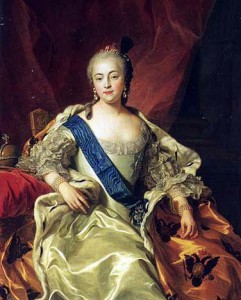
Elizabeth Petrovna (Episodes 40 and 41) was born on December 29, 1708 as the daughter of Peter the Great and Catherine I. Her reign, from December 6, 1741 to January 5, 1762 was marked with enormous expenditures of money on the arts and architecture. She was one of the most popular monarchs in Russia’s history in part because of her outlawing execution.
Her father, Peter I, was a towering figure. His legacy would cast a huge shadow on the people of Russia for centuries to come. To be the daughter of a legend must have been hard but Elizabeth was up to the challenge. She was betrothed to Prince Karl Augustus of Holstein-Gottorp, son of Christian Augustus, Prince of Eutin but he died a few days after the betrothral. She was never to marry and would have no children to succeed her.
After her father died, her mother Catherine took over but her reign was brief, lasting only two years. After her death, her cousin, Peter II who was the son of Peter the Great’s brother Alexis assumed the throne. He lasted less than three years and with his death, Peter the Great’s niece, Anna Ioannovna took over as Empress of Russia from 1730 to 1740. Shortly before she died, she named her grandnephew Ivan VI as heir but the boy was a mere one-year old. His mother, Anna Leopoldovna became regent but she was widely disliked because of her German advisers. Within two months he was overthrown by Elizabeth and her allies and locked away never to be heard of again. When guards tried to free him, he was murdered at the order of Catherine the Great.
Assuming the throne as Empress on December 6, 1741, Elizabeth was to reign for twenty years. She was head of Russia during a trying time with the Seven Years War raging throughout Europe. Elizabeth and her policies were to have an enormous influence on the outcome of the war. Her domestic policies were solid as they continued with the ideas of Westernization started by her father.
She knew that without a child, a succession issue would arise so Elizabeth selected her nephew, son of her sister Anna, Peter of Holstein-Gottorp as the next in line. Next up was a wife for him and after much debate she picked Princess Sophie of Anhalt-Zerbst who was christened Catherine when she converted to Orthodoxy.
When Catherine gave birth to a son Paul, he was snatched from his mother and raised by Elizabeth. This cause a great deal of emotional distancing to take place between mother and son. After Elizabeth died in 1762, Peter III was crowned Tsar but his reign would only last for six months before he was overthrown and killed by a coup that elevated his wife Catherine the Great to the throne.
Elizabeth’s legacy is positive although unremarkable. While she cannot be rated as one of the best Russian rulers of all time, she certainly does not come close to being one of the worst.
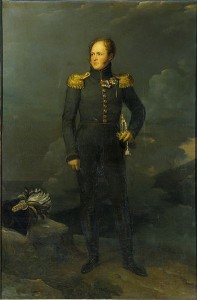
Tsar Alexander I, also known as Alexander the Blessed was born on December 23, 1777. His rule of Russia from March 24, 1801 following the assassination of his father Paul I, was a tumultuous one. The crowning glory of his reign of course was the defeat of Napoleon Bonaparte during the Napoleonic Wars.
Born to Paul Petrovich Romanov and Maria Feodorovna née Sophie Dorothea, he was raised primarily by his grandmother, Catherine the Great. She had little faith in his father Paul which caused Alexander a great deal of difficulty later in his life. He tried to appease both his grandmother and his father which led to his doing the same when he became Tsar in 1801. Throughout his reign, Alexander tried to make everyone happy but he was also a master manipulator as well.
After the murder of his father Paul in March of 1801, Alexander assumed the mantle of the Russian Empire with a great deal of guilt. Some say he knew that the conspirators led by Counts Peter Ludwig von der Pahlen and Nikita Petrovich Panin were planning the murder, others thought not. It is clear that he knew of the plot to remove his unpopular father from the throne. It is equally clear that they did not tell him of their nefarious plans. Nonetheless, Alexander did take over (Episode 53) for his father at the age of 23 with the admonition “Time to grow up! Go and rule!” by General Nicholas Zubov.
Early on in his reign, Alexander began to try to reform the country especially the government. Led by the liberal Mikhail Speransky reforms were drawn up and ready for action. Some of the reforms came to be, but for the whole, not a lot was done partly due to a problem that was cropping up in Europe; the arrival of Napoleon Bonaparte to the world stage.
It was his battles with Napoleon (Episode 54) that made Alexander I the hero that he became to his people. Starting in 1807 and finishing in 1814, the war against Napoleon had its ups and downs but eventually, Alexander and his Russian army prevailed. After this though, the Tsar’s personality took a conservative and somewhat mystic turn.
In 1825, in the town of Taganrog Alexander supposedly died after a short illness. Rumor though has it that he did not die that he became the monk Feodor Kuzmich. Some in the Romanov family were told that the two men were one and the same and there is actually a book called Imperial Legend: The Mysterious Disappearance of Tsar Alexander I by Troubetzkoy that claims the same thing. Whatever the truth, his brother Nicholas I takes over for him and begins the slide that the Romanov’s never recovered from.
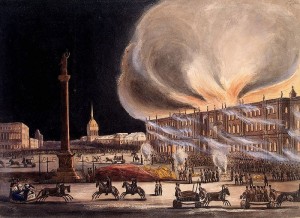
On December 17, 1837, the Winter Palace caught on fire. The official home of the Tsar’s of Russia, it was first built starting in 1711 commissioned by Tsar Peter the Great. The first Winter Palace was designed by Domenico Trezzini, a Swiss-Italian architect. Trezzini’s most famous work that still stands today is the Peter and Paul Cathedral.
Peter I, as he was want to be, soon grew tired of the building and commissioned a second one to be built. This time he switched architects to Georg Mattarnovy. It was in this version of the Winter Palace that Peter was to die in 1725.
Peter II, decided in 1727 to redo the building his grandfather had begun. This time he brought back Trezzini who decided to make it a far grander palace. The third version of the Winter Palace was completed in 1728 but Peter decided to move the court to Moscow. With his death in 1730, Anna I decided to move the court back to St. Petersburg. She wanted a more grandiose palace so she called in Francesco Bartolomeo Rastrelli to make it so.
It was under Elizabeth I that the palace really took shape. At a cost of over 2.5 million rubles, it was truly spectacular. But under Catherine the Great, things really became extravagant. Incredible art pieces were installed throughout. The Hermitage was built adjacent to the Winter Palace by Catherine in 1764 to hold the overflow of art.
More art poured into the Winter Palace after taking many masterpieces from Napoleon’s ex-wife Josephine. Alexander I and Nicholas I continued to upgrade things with the latter being responsible for the rebuilding after the fire in 1837. It now contains 1,500 rooms, 1,786 doors and 1,945 windows which is staggering to say the least.
Because of its size, after the assassination of Alexander II, it was deemed to be too big to protect the last two Tsar’s. The the Palace of Gatchina was now the primary home, some 40 miles from St. Petersburg. Nicholas II decided that this didn’t suit him and his family and moved them to Tsarskoe Selo.
Under Soviet and current rule, the Winter Palace is part of the overall Hermitage museum. It attracts over 3.5 million visitors each year. It is a marker for the decadence of the Russian Tsar’s and a monument to incredible art. Hopefully, in the not to distant future I will be able to visit the Winter Palace which I understand was not very far from where my ancestors lived.
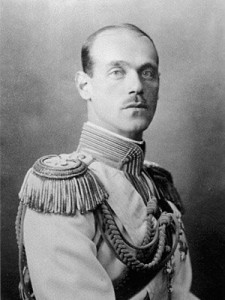
On December 4, 1878, Mikhail Alexanderovich Romanov, the last Tsar of Russia was born. He was the youngest son of Tsar Alexander III and brother of Tsar Nicholas II. He was the first, but not the last, Romanov to be murdered by the Bolsheviks.
Born into royalty, when he was born he was fifth in line to the Romanov dynasty. When his grandfather Tsar Alexander II was assassinated in 1881, he moved up to fourth. With the death of his father Tsar Alexander III in 1994 and the ascension of his brother Tsar Nicholas II, he became second in line behind his brother George. George died in an motorcycle accident in 1899 which made Mikhail the next in line. When Nicholas’s son Alexei was born, he was no longer next but because of the boys delicate health, having hemophilia, he was regarded as the likely heir should anything happen to his brother.
While most would think that being born into a family as wealthy as the Romanov’s would mean a life of luxury, it was not so with Mikhail and his siblings. Tsar Alexander III believed that the children should live a spartan life, sleeping on hard beds, and washing themselves in cold water. Still, life for them was far better than the majority of Russians of the time. Life changed dramatically for Mikhail as his father died when he was just 15 years of age. He was quickly enrolled in military school to prepare him for the potential to take over as Tsar should it come to that.
His love life began in controversy as he fell in love with his first cousin, Princess Beatrice of Saxe-Coburg and Gotha. Their proposed marriage was denied by both the Russian Orthodox Church as well as his brother, Tsar Nicholas II. He reluctantly ended the relationship. Next up was a relationship that horrified the Tsar’s family as Mikhail fell in love with a commoner, Alexandra Kossikovskaya. Dina as she was known was never accepted by the family as they had her followed constantly by the Russian secret Police, the Okhrana.
Eventually, he met someone Natalia Sergeyevna Wulfert, the wife of a fellow military officer. The Tsar’s family was once again aghast at Mikhail. Eventually she would divorce her husband to marry Mikhail but much to the chagrin of his family, she gave birth to a boy George, before the divorce was finalized. The Romanov’s back dated the divorce to avoid further embarrassment.
When World War I began, Mikhail asked to return to Russia with his wife and child to help with the war effort. He served bravely in the war but he felt that it was a tragedy for the people. With the war going so poorly for the Russians, he was further dismayed when his brother Tsar Nicholas II decided to take over as Supreme Commander. His countless mistakes caused great suffering and terrible casualties among the brave Russian soldiers.
Mikhail believed that the people were beginning to oppose his brothers reign and told him so in a letter in 1916. By March 15, 1917, Tsar Nicholas II abdicated, first giving his son Alexei the throne but after careful thinking, he changed his mind and gave up his throne to brother Mikhail. He wrote, “We have judged it right to abdicate the Throne of the Russian State and to lay down the Supreme Power. Not wishing to be parted from Our Beloved Son, We hand over Our Succession to Our Brother the Grand Duke Mikhail Aleksandrovich and Bless Him on his accession to the Throne.”
Mikhail was not told of the decree until the next morning. After careful deliberation and pressure from the Provisional Government, Mikhail conditionally declined the offer, effectively ending the Romanov Dynasty. Nicholas was very disappointed but had little choice in the matter.
On August 21, 1917, Mikhail was put under house arrest and while later released, the Bolsheviks, now in power, rearrested him. On June 13, 1918, Mikhail Alexanderovich Romanov, would become the first of the royal family to be murdered. It was an ignominious death of a man so close to the pinnacle of power as the presumptive last Tsar of Russia.
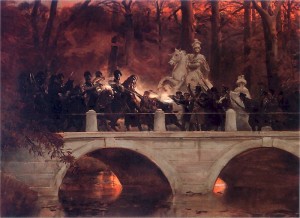
On this day in 1830, Polish cadets, tired of being under the thumb of Russia after being partitioned post-Napoleonic wars, decided to revolt to free Poland from tyranny. While initially successful locally, they were eventually crushed by the better equipped and numerically superior Russia army.
Poland had been partitioned between Prussia, Russia and the Hapsburg Empire in 1795 and completely enveloped by Austria, Russia and Prussia in 1815 due to its aid to Napoleon. Poland was supposedly a autonomous country with a constitution but was allied to Russia through the Tsar as King of Poland. Increasingly, over the years, the Tsar’s, Alexander I (Episode 53) then Nicholas I (Episode 56) disregarded the constitution entirely. Instead they made Poland their fiefdom and did as they pleased. This stewed a growing animosity among the entire population and in particular, the nobility and military.
In 1815, Alexander I appointed Grand Duke Constantine Pavlovich, his brother, as viceroy of Poland. Constantine was considered a tyrant by the Polish people who despised him. On November 29th, things began to boil over. A group of young cadets, led by Piotr Wysocki attacked the Belwedere Palace where the Grand Duke lived, trying to capture him. They were unsuccessful as Constantine escaped wearing women’s clothing.
Prince Adam Jerzy Czartoryski tried to negotiate a peaceful resolution with the Grand Duke who initially agreed to be lenient with the cadets but radical members of the Polish military and government rejected the offer. All but two of the General’s of the Polish army went over to the rebels. A provisional government was formed with General Jozef Chłopicki being named Dictator of the Uprising.
Chlopicki did not favor a war with Russia as he felt there was no way it would be successful but he bowed to the pressure of the people. He tried to quell the uprising by appealing to Tsar Nicholas I by sending Count Drucki-Lubecki to St. Petersburg. The mission was futile. The Tsar demanded full capitulation or face military intervention.
The Sejm, the governing body of the Polish government declared that the union between Poland and Russia was null and void on January 25, 1831. They proclaimed that “the Polish nation is an independent people and has a right to offer the Polish crown to him whom it may consider worthy, from whom it might with certainty expect faith to his oath and wholehearted respect to the sworn guarantees of civic freedom.” It was, for all intents and purposes a declaration of war.
Without going into details, the war did not go well for Poland. By October 5th, 1831, the last of the rebellious troops crossed the border to Prussia and laid down their arms. Over 40,000 Poles were either killed or wounded. The Russians suffered around 23,000 killed or wounded with an additional 5-12,000 dying of disease. While many historians believe that Poland could have won the war had they been more unified but the fact remains that the resources of Russia were far too great for a successful Polish outcome.
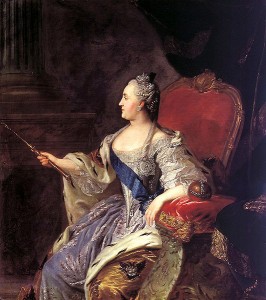
On this day in 1796, Catherine the Great (aka Catherine II) passed away in her commode (Episode 51) at the age of 67. She was considered, along with Peter the Great, as one of the greatest leaders of the Russian Empire. Her son Paul I was to take over and reign for a little over four years. Paul despised his mother and did much to reverse many of her policies. He put into law that only male heirs to the throne were eligible setting up the way for the decline of the Romanov dynasty.
She was the wife of Peter III and upon his murder during a coup d’etat on July 16, 1762, she took control of the government. Born, Sophie Friederike Auguste von Anhalt-Zerbst-Dornburg, she was hand-picked by Empress Elizabeth (Episodes 40 and 41) the daughter of Peter the Great. The marriage was a disaster and likely was never consummated. Fearing that she would be sent to a nunnery and divorced, she decided along with her friends the Orlov brothers, to stage the overthrow. What helped her was the fact that Peter III was generally disliked and had sided with the Prussians during the wars going on at the time.
The era of Catherine’s reign is generally considered the Golden Age of the Russian Empire although the vast majority of the people living in Russia at the time were incredibly impoverished. It was also the time of one of the greatest revolts in Russian history, the Pugachev Rebellion (Episode 47).
Her time as Empress of all of Russia was a time of great expansion and a instilling more European style into Russian society. Catherine was one of the few Russian leaders (post Peter the Great) to have no direct heritage to previous rulers (Catherine I was the other). She was also a great patron of the arts and commissioned the building of the Smolny Institute the only school of higher learning for women in Russia.
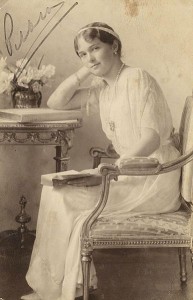 On this day in 1895, Grand Duchess Olga Nikolaevna Romanova was born to Tsarina Alexandra Fyodorova and Tsar Nicholas II. She would be murdered with the rest of her family on July 17, 1918 when she was just 22 years of age. Because of her murder, she, along with the rest of her family were canonized by the Russian Orthodox Church as a passion bearer.
On this day in 1895, Grand Duchess Olga Nikolaevna Romanova was born to Tsarina Alexandra Fyodorova and Tsar Nicholas II. She would be murdered with the rest of her family on July 17, 1918 when she was just 22 years of age. Because of her murder, she, along with the rest of her family were canonized by the Russian Orthodox Church as a passion bearer.
As an aside, you might notice that her last name is Romanova and not Romanov. In Russia, females have different last names from the males, so in her case, an “a” is added to the end. If the ends in a “y” like Rimashevsky, the feminine would be Rimashevskaya.